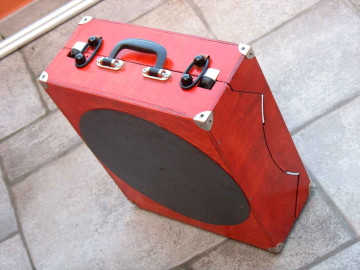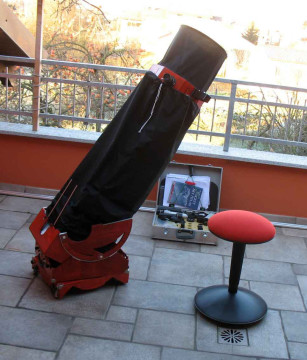In support of the fact that the balance of light Dobsonian (and not), It can be done dynamically as an alternative to the use of counterweights, I do narrate here my recent experience to rebalance with elastic rubber my Dob250F5, After adding optical finder 6×30 weight of 265g.
In order to fully understand what the physical principles and rules for the construction of a dynamic balance (provided equally by springs or rubber elastic bands), that turn into tractive power the required weight, and therefore excludes the use of any counterweight, could be deepening this topic to read about it, that I wrote here, in another article entitled "practical DYNAMIC BALANCING of DOBSONIAN TELESCOPE, WITH SOFT " https://www.grattavetro.it/pratico-bilanciamento-dinamico-di-telescopio/
NOTE:
But be warned that the most difficult balancing in lightweight telescopes, It is not a solution of every problem, because today's market trend, also favors an aspect in open contradiction with the lightening, which it is the spread of wide field eyepieces, who weighs 5 times higher than eyepieces of few years ago.
A lightweight telescope, even if well balanced, still does not have enough friction to hold firm his “nose”, at the change of the wide-field eyepieces, within a wide range of weights like 5 times the weight of a normal eyepiece of 10 years ago.
Example: To use on my Dobsonian 300F6 a spectacular wide field eyepiece and low magnification that can weigh 1 kg, should counterbalance with 6kg, while for an eyepiece 200grams only serve 1200 grams.
The fact is that to ensure that the 300F6 telescope keeps the nose firmly fixed, during the exchange of these two eyepieces having so different weight, would that it had a sliding static friction able to maintain its retainer pointing to the eyepiece with a weight change between zero and (6-1.2)= 4.8 kg..thing that is really impossible…. Unless it's a Dobsonian telescope not lightened type, Obsession like , or for one lightened telescope, but having installed, a parking disc brake, type the one I described here: https://www.grattavetro.it/costruzione-dobson-light-300f6-con-freno-a-disco-fase-1-realizzazione/
(Realization also published in the November issue 2016 the American magazine "Sky & Telescope”, under the columns of: “Astronomers Workbench”, on pages 66-67):
Only with some kind of parking brake can a light telescope withstand any eyepiece changes without moving.
NOTE end:
Having made this necessary clarification, let's go back to balancing with rubber bands:
To remedy the deficiencies of increasingly polluted and bright skies , I got the "trip" to also extend to the ultralight dob 250F5 …


the hardware of my 14 ", adding near the Quickfinder without magnification, a further small optical optical finder 6×30.
The Quickfinder, such as Telrad, become useless if used alone under heaven that does not show field stars visible to the naked eye, as a reference for finding objects in low sky areas , and therefore most polluted areas.
While the same addition finder to the "Rocky" 14" hadn't disturbed her balance, applied instead to 10"″ 250F5 ultralight, of which his weighing with the new finder has risen to 7,8 kilograms ready for observation….he imposed a rebalancing.
The first determination completed after mounting the new Finder (and installation of all hardware ready telescope use observational, and inclined towards the horizon), It was to quantify the balancing weight that would be necessary to add to the primary case.
To do this I have applied to it a littled palstic bag , in which I added gradually, lead fishing spheres each from 20 g, (of the type used by fishermen), until it reaches the equilibrium condition with 1175 grams of lead.
Due to its small weight to be transformed into traction, the choice fell on the elastic type of trunk diameter 4mm car (against elastic 6mm standard) sold by the meter in supermarkets "DIY".
I also planned to put a single elastic stretch to simplify Assembly by eliminate the needs for two of the four anchor points that would have been necessary with the use of two separate elastics.
Also the single elastic, resulting in longer than two elastics, is constructively favourable both to reaching without appreciable elongation problems imposed by the inclination of the telescope, ; and the natural load distribution, that becomes self-equilibrating both the two sides of the telescope, bypassing the problem that with the use of two separate elastic, one of them would end up with time to pull less than the other.
VERY IMPORTANT RULE: As explained in a more extended wai in the article mentioned above, the elastic rubber, to Work well as a dynamic counterbalance , must be able to provide a growing force as is growing the cosine of the angle of inclination of the telescope, and to do this, it is necessary that the rubber elastic has its two terminals returned each by a pulley-like towards the engagement to extremes Crescent bearing, in such a way that their stretching, and with it the growing arm of pulling force, grow grows just like the cosine of the angle of inclination of the telescope.
For this reason we installs two mechanical referral on rockerbox, in my case in the form of two small wooden knobs (used for the drawers of furnitures), with their head in fungus belonging pulley function, on that stalk the elastic strap slips upward during the elongation.
Recalling that on normal Dobsonian (ie excluding lightweight models), the considerable weight and size of primary mirror box resting on Crescent side bearing (armed with teflon that flows on Formica having "Sandy" surface ), provides some attrition that is essential to ensure that the telescope does not move too freely to a minimum change of inclination, or at the minimum lighten becoming from changing the eyepiece, We must note that this desired friction coming from the weight, is extremely difficult to produce on telescopes ultra lightweight and ultra transportables.
An alternative solution so to produce that indispensable friction, is to brake the elastic elongation in playing on small shank diameter of referrals, and also on the number of additional references, and on their mutual distance, to be installed along the path of the elastic, upstream the Terminal of the "cosine", so while observing, the strap can be zig zag attached on a experimentally number of those referrals, creating a brake to the elastic scroll, with higher force as many are referrals to zig zag that the operator decides to activate at the moment.
The length of the elastic path at rest (with almost no traction) in my case is measured in 1360 mm
While the full 90 ° inclination of the telescope, the elastic path increases further 480 mm, bringing the total length to 1750 mm
The practice regulation of traction to reach those 1175g is very easy and intuitive, and the way are more than one.
My easiest way is to hook one end of the elastic on one end of a crescent “side bearings”, and then simply try to progressively shorten the elastic, knotting experimentally at the other end which is hooked to the other side bearing (..redoing the increasingly experimental advanced node in the appropriate conical seat at end of the hooks of standard type), to adjust the balancing behavior during the inclination.
After a bit of trial, we have a traction that is fairly well "centred", at that margin of virtual values of friction “minimum and maximum” covered by the action of sliding friction crescents, generated between teflon and (…in my case) aluminum , which add to the friction sliding surplus product on the elastic band from the famous zig zag, by (..in my case) two additional knobs, as seen in the third and fourth of the following images:
The result was positive, and the traction of rubber bands (2 zig zag compresi) increased friction of the side bearings allowing me to change almost all of the eyepieces weighing within 200 g, without the telescope lift the "nose". Which is a good result .... though perhaps still it requires the installation of at least one other pair of zig zag knobs (or vice versa, alternatively, the mutual approach of those knobs already installed), to increase the friction so that you get to compensate for heavy replacement eyepieces over 200g, full of lenses ... for a nice wide field…which moreover Inever bring with me in air travel, using preferably only one convenient and affordable Celestron 8-24 mm zoom eyepiece.
We will wonder: Why not balance it also for wide-field eyepieces?. Why, I'm kind of a minimalist in every sense. And the reason leads me to think that, how you can't have your cake and eat it too,; You can't have a good dobson very lightweight (My 250F5 I remember that it weighs 7, 8 kg throughout) e comfortably stable, within a wide margin of ocular weights, they are heavy and awkward to carry around in several numbers.
The technique moral (..but also minimalist) of all this work, is finally, that not always simples and unattractives things are malfunctioning.






